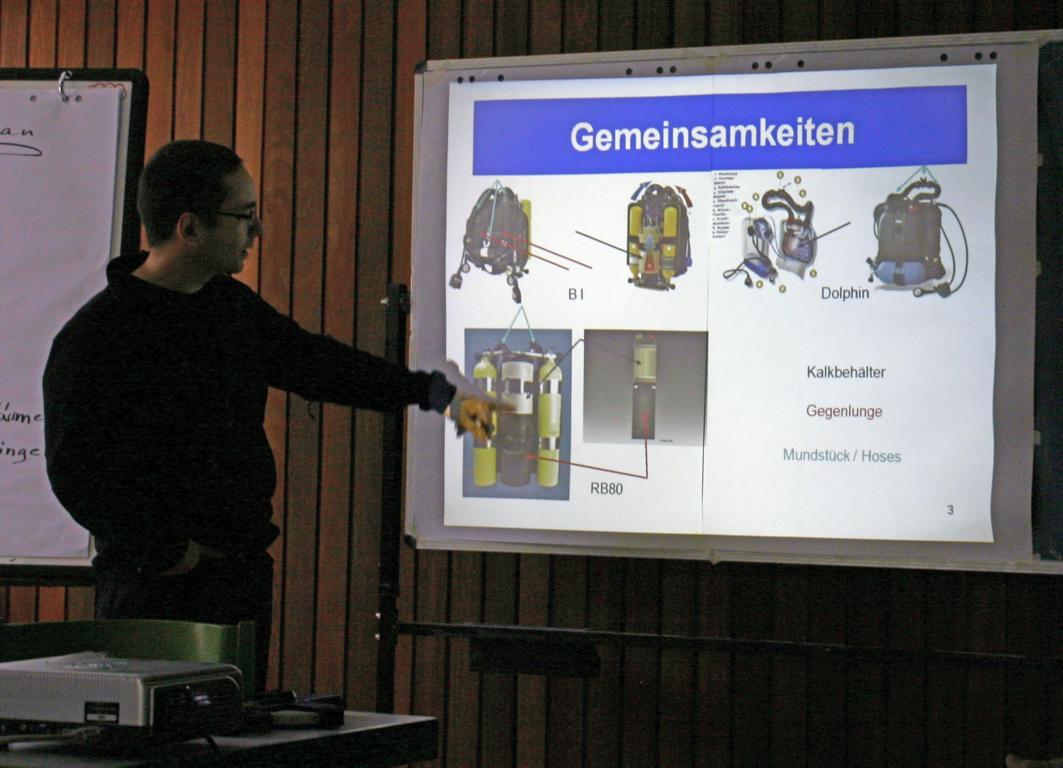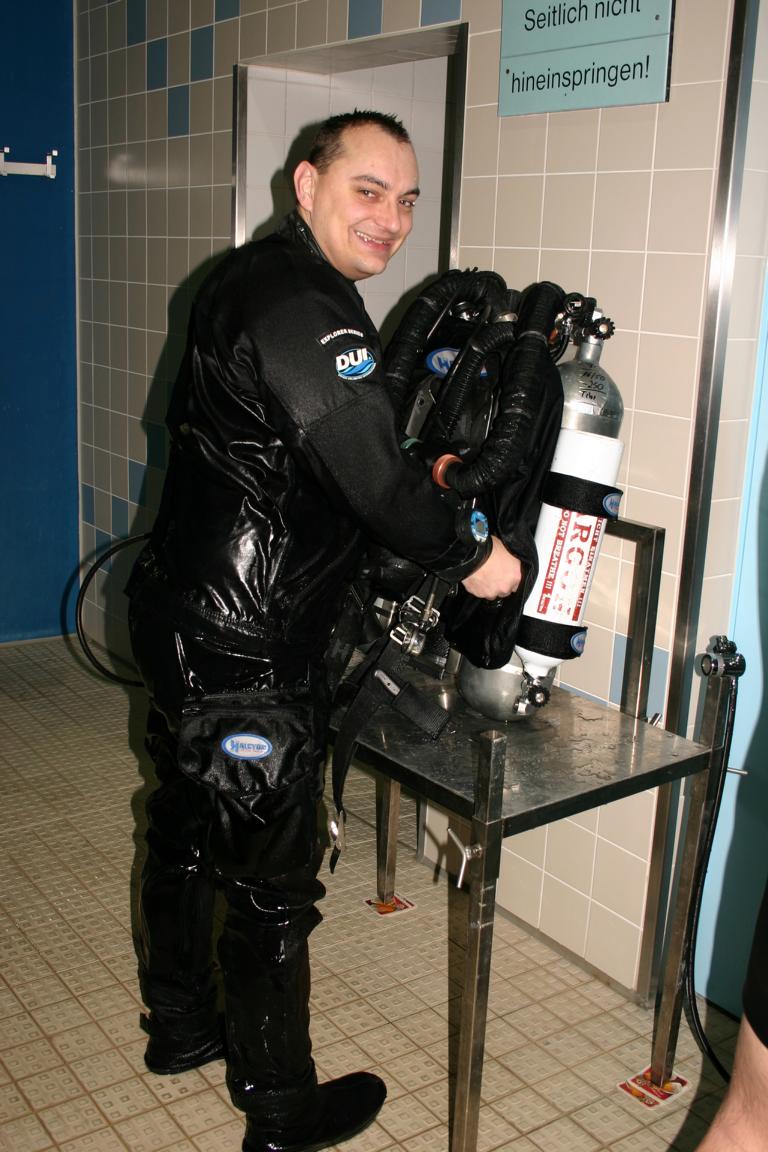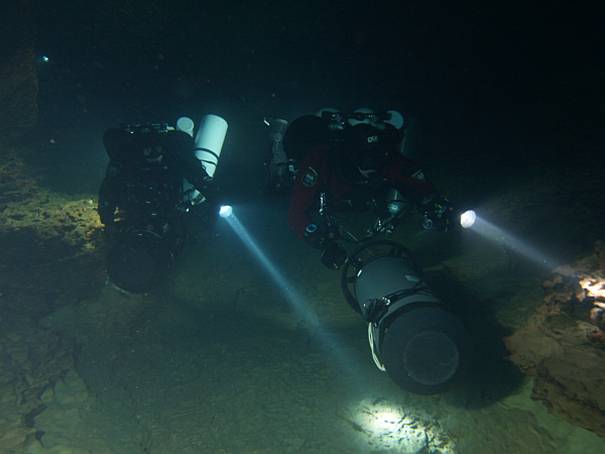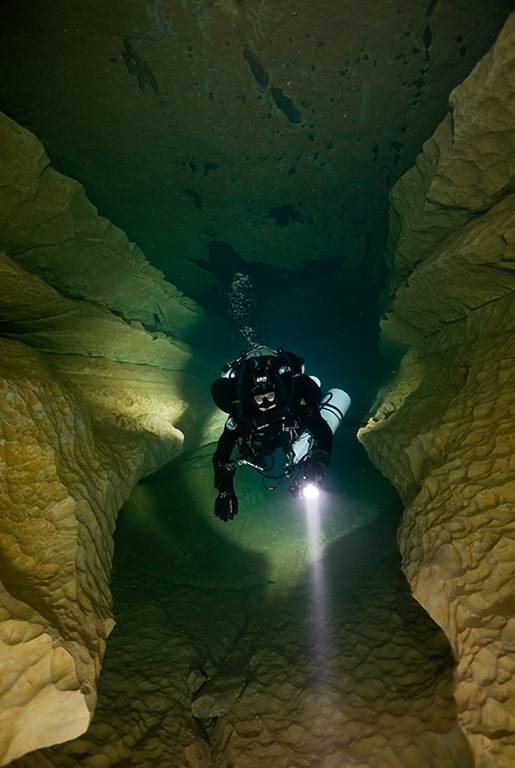- Read Time: 6 mins
RB - Workshop and Training
Team: Roland Kring, Peter Gärtner, Manu Schoch, Stefan Bayha, Tim Löffler, Oli Kurtz, Marc Grosse, Tobi Ziegler, Tibor Czuppon, Manuel Fiore, Fred Petzinger, Günther Kirschner, Michael Winter
After we had already met on the weekend of January 8th - 10th at Lake Constance to plan our activities for the year 2010, now point no.1, a RB workshop with practical training was on the agenda.
The goal was not only to work out a common standard for our RB divers, but also to introduce and train the OC-ers in the world of gyro diving. Not to forget the fun factor, which is very important for us : )
The training should have a workshop character - therefore not only Peter as "workshop leader", but also all participants had prepared themselves with a contribution to the workshop, which they then also presented themselves.
Day 1
We met on Saturday 5.2 in Böblingen, where Peter organized a training room for us. Although some had a very long journey, we could start punctually at 9:30 with the first point of the agenda:
General HELLO, the last meeting was not long ago, but still there was a lot to talk about!
After we had quickly agreed on the key points for today, in order to be on time in the evening at the swimming pool for the practical part of the weekend, Tobi Z. and Peter already started with the workshop. Of course, the gyroscopes also have a history, which was first discussed in detail.
A current long-running issue in the field of technical diving is the discussion of the advantages and disadvantages of the different RB concepts such as PSCR, MCCR, ECCR, etc., which was also not to be missed in our workshop. Here it should be said that the PSCR is still the standard in Team CAVEBASE.
The structure and functionality of the PSCR was next on the list. Here, in addition to the different PSCR types, the possible errors were discussed in detail. In addition to the errors and their causes, the focus was also clearly on the avoidance or early detection of defects. Which checks are necessary to ensure the function of the rebreather (during assembly, in the water, what can I recognize as an OC-ler). Roland and Peter gave us checklists, which we defined as standard for our team.
Since we are in the lucky position to have an almost complete doctor in our ranks, we got another excursion into the topics of physiology and medicine. We then went into more detail on the points of hypercapnia and hypoxia during the training.

Before we left for the swimming pool, Roland gave us a practical introduction to assembling a PSCR.
In Water Session → Connections Stefan has, we were allowed to use the pool in Bietigheim the whole evening alone and undisturbed. From 7pm we were allowed to carry our equipment to the water and started with the assembly. Many thanks again to the TSC Bietigheim!
In the indoor pool, everyone first went through the checklists and procedures. An experienced RB diver was always assigned an OC or RB beginner. The procedures were then demonstrated and explained to this person in presentation quality. So everybody benefited equally from the first part of the pool session - some learned something new, others could work on fine tuning their skills.
In the second part, the hypoxia and hypercapnia test had to be completed. For one or the other there was certainly an eye opener for the symptoms. Both tests were performed in mild forms in order to be able to "enjoy" the symptoms nicely one after the other. Especially after the hypoxia test, the blue lips and plate-sized pupils were clearly visible. But in water, with hypoxia, the symptoms are not easily recognizable in themselves, so some, after an appropriate break, repeated the test. Now, with sharpened senses, however, everyone noticed the symptoms in themselves.
The relatively mild hypercapnia test was also an experience: it is almost unbelievable how easily one can overbreathe the box and how quickly breathing then gets out of control.
It was a reassuring feeling during both tests to have had a paramedic and an almost fully trained doctor with intensive care experience with me! Because despite the fact that all tests were performed with the greatest possible safety and only under double direct supervision, every organism reacts differently. And so we could be sure that we had done everything humanly possible to prevent accidents.
These tests should actually be mandatory for every PSCR diver - after all, it is hypoxia that poses the greatest danger in the unit. Nevertheless, it is strongly advised against imitation without the supervision of people who know what they are doing!
Finally, there was the opportunity for some still-OC-ers to infect themselves with the RB virus - happy faces were the result. Actually mean - the RB taster dive has something of anfixen!
After a successful, very interesting and exhausting day with, here I can speak only for myself, brilliant impressions, we had only one common goal → food intake :-)
After the common meal at the Schotten we split up, a part went with Stefan and the rest to Manu and Peter who granted us asylum in your witch cottage (thanks again to you two!!!). There we let the day end until the early morning hours.

Day 2
Since we still had some program planned for Sunday, we started the day with an extensive WEISSWERSCHD BREAKFAST at Manu and Peter. Almost on time at 9 am the first sausage landed in the pot and we could start with the program around 10:30 am.
In addition to the remaining equipment topics such as hose routing, mouthpiece, general configuration and the switch block, we conducted a risk analysis led by Peter in connection with the debriefing of the IW session - probably none of the participants would have expected the clarity of the result.
Building on this, we looked again at our procedures and checklists and fine-tuned them.
The discussion about bailout planning and decompression in the RB with Roland formed the conclusion of the official program.
The end of the exhausting, instructive and nevertheless extremely fun workshop around 3:00 p.m. was the feedback round, which of course could not be missed.
Conclusion
In addition to all the content-related issues that have increased the effectiveness and safety of the team, it has once again become clear: diving has to be fun! Otherwise, the motivation and commitment of each individual cannot be kept at a level that requires the implementation of complex cave diving projects. And the fun, that much is certain, did not come too short! We are looking forward to implementing what we have learned together as soon as winter has turned its back on Europe!
With this in mind,
Your Cavebase
Gallery
[module-228]



















